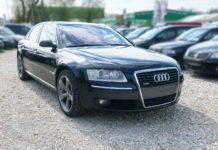The BMW Group has been recycling “new cars” for 30 years now, thanks to their Recycling and Dismantling Centre (RDC)— the world’s coolest auto chop shop, but with way more science and far fewer dodgy deals.

Let the recycling begin !
It all started in 1994 when BMW decided it was time to give pre-series vehicles a more dignified retirement plan. Cars roll in for a final oil drain (even the oil from the shock absorbers is drained) and all the other fluids are drained as well. After this it’s time to disarm the airbags. That’s right, before anything else, they make sure the pyrotechnics in those airbags are neutralized so there are no surprise fireworks.
Next, they get to work pulling out any parts that still have some life in them including engines and transmissions. If a component is looking as fresh as the day it rolled off the assembly line, it gets passed on to registered dealers for resale. Basically, it’s like a thrift store for car parts, where only the top-quality pieces make the cut.
Once the car’s been picked clean of anything reusable, it’s time for the heavy lifting. A specially designed excavator comes in to separate valuable materials like copper from the wiring harnesses, making sure none of that good stuff goes to waste. It’s like panning for gold, except it’s all happening inside your average sedan. After that, the engine block and gearbox are whisked away, and the rest of the car? Well, it gets squashed and shredded into a compact little cube—perfect for starting a new life as tomorrow’s raw material.
And when it comes to metals, the RDC knows how to turn scrap into cash. Copper and other powertrain metals are like the hidden gems of the recycling world, fetching a pretty penny. And don’t forget about the catalytic converter, which is basically the treasure chest of car parts, loaded with precious metals that make recycling it not just eco-friendly, but economically savvy too.
As you can see on the pictures these are basically new cars, however most of them are pre-series vehicles used for testing which can’t be sold to the end customers.

BMW isn’t just recycling cars—they’re handing out cheat sheets available free of charge to recycling companies around the world. Through their IDIS (International Dismantling Information System) platform, they’re sharing their data and findings with over 3,000 recycling companies in 32 countries, helping the entire world learn how to dismantle recyclable components cost-effectively and recover valuable materials efficiently. It’s like BMW’s version of a cooking show, but instead of soufflés, they’re teaching you how to recycle catalytic converters (and trust me, that’s where the money is—those things are stuffed with precious metals).
Average car life in Germany – 21 years
At the RDC, every scrap of knowledge they pick up about recyclability gets sent straight back into the BMW Group’s product development lab. It’s like a feedback loop for car parts—anything they learn about what works, what doesn’t, and what can be easily recycled gets baked into the design of future vehicles. As the vehicles reach the end of their useful life, which in Germany is on average 21 years, BMW wants to make sure that these vehicles will be available as a source of raw materials for new cars.

Recycling of electric cars
With electric vehicles becoming more common, it makes sense that figuring out what to do with those big batteries has become a “top priority.” BMW’s RDC has been working on this for years, teaming up with industry and academia to develop all these innovative recycling methods. Sounds great in theory—but we’re still waiting to see how it all plays out on a large scale.
The RDC, we’re told, is once again “setting the pace” for the circular economy, which is a nice way of saying they’ve been at this recycling game for three decades. They’ve definitely made strides with new models, materials, and technologies, but now, with electric cars on the rise, they’ve got an even bigger task: becoming experts in reusing valuable resources from those hefty batteries. And they’re not keeping it to themselves—they’re sharing all this knowledge with the recycling industry to help get everyone on board.
Of course, the big claim here is that the RDC is consistently expanding its role as the go-to place for vehicle recycling. It sounds promising, especially as the world turns to greener solutions, but there’s still a bit of a wait-and-see vibe. How fast will these battery recycling methods become widespread? The need is definitely growing, and the RDC’s expertise will be in demand, but time will tell just how quickly all these big ideas turn into tangible results.




















